Management of Law: Case Study Analysis and Legal Principles
VerifiedAdded on 2020/03/16
|7
|1502
|32
Case Study
AI Summary
This case study analyzes four different legal scenarios under Australian law, focusing on contract law, negligence, and consumer rights. Case 1 examines the validity of a prenuptial agreement under Australian contract law, considering elements like offer, acceptance, and free consent. Case 2 explores whether an individual is legally obligated to purchase a car after expressing interest in an advertisement, determining if the advertisement constitutes an offer. Case 3 assesses the negligence of an individual who prepared poisonous food for a friend, considering the duty of care and the defense of volenti non-fit injuria. Finally, Case 4 investigates a consumer's rights under the Australian Consumer Law (ACL) when a product received does not match the specifications advertised. The analysis references relevant legal provisions, case law, and consumer guarantees to provide a comprehensive understanding of the legal principles involved.
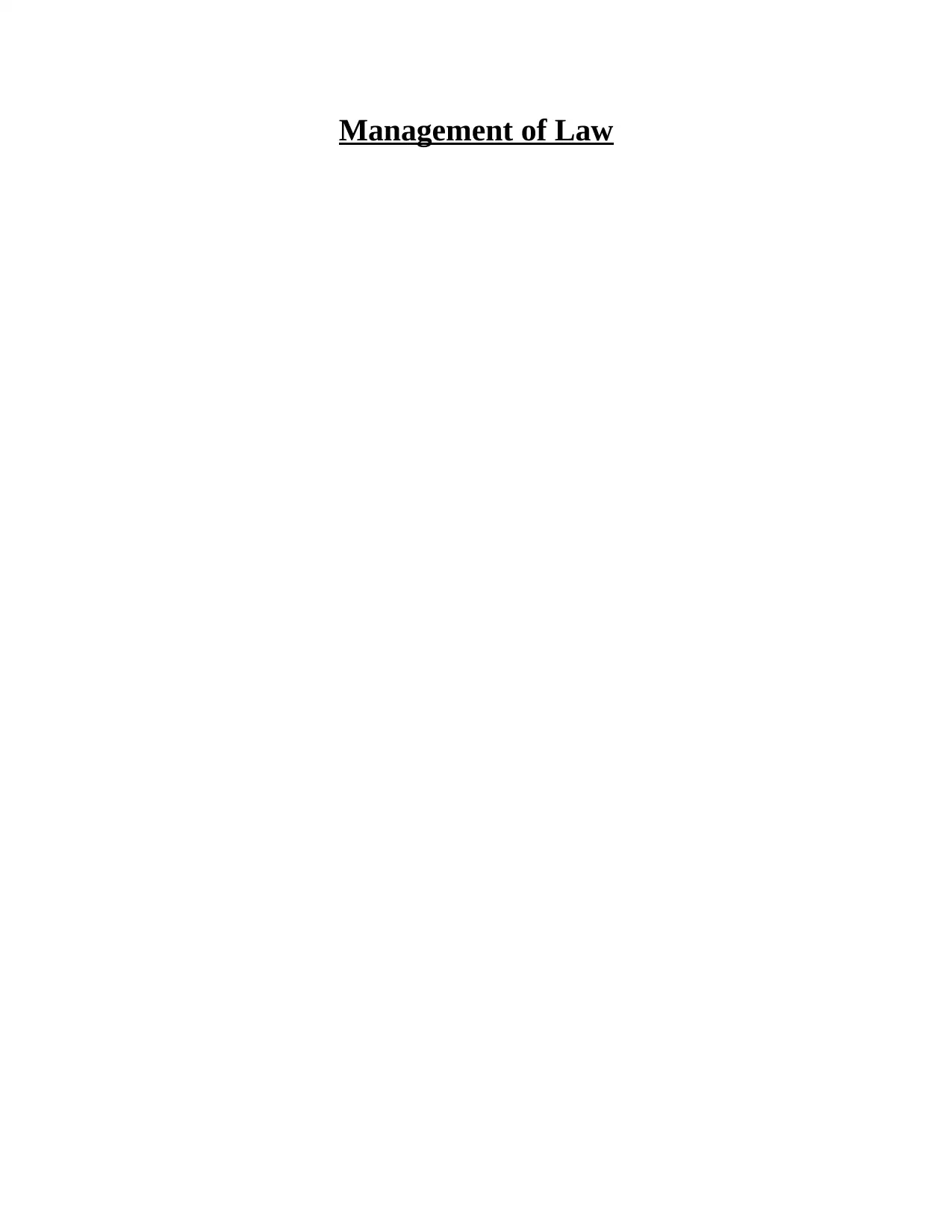
Management of Law
Paraphrase This Document
Need a fresh take? Get an instant paraphrase of this document with our AI Paraphraser

Table of Contents
Case 1..........................................................................................................................................................1
Case 2..........................................................................................................................................................2
Case 3..........................................................................................................................................................2
Case 4..........................................................................................................................................................3
REFERENCES............................................................................................................................................5
Case 1..........................................................................................................................................................1
Case 2..........................................................................................................................................................2
Case 3..........................................................................................................................................................2
Case 4..........................................................................................................................................................3
REFERENCES............................................................................................................................................5

Case 1
Issue
Tom, a middle-aged businessman, told his would-be-wife a week prior to their wedding that he
will marry her only if she signs an agreement that explicitly states that she will only get $100,000
if they get divorced. If they stay married, then she will get his house, car, and other physical
things. Susan signed the agreement reluctantly. They got divorced after five years. The issue is to
identify if the agreement signed by Susan was valid.
Legal Provisions
All agreements are contracted as per the Australian Contract Law if they meet the following
conditions:
Offer and acceptance
Consensus-ad-idem
Free consent
Legal object
Legal consideration (Grau, 2014)
Possibility of performance
Competency of parties to contract
Applicability
Clearly, an offer was made by Tom to which Susan agreed by signing the document. This makes
the agreement valid. Moreover, both the parties mutually consented to sign the document and
there was no use of force, undue influence or coercion. A legal object was pledged i.e. $100,000,
in event of divorce. Taking reference from the judgment in the case of Australian Woollen Mills
Pty Ltd vs. The Commonwealth, there was also a legal consideration i.e. if the agreement was
signed, Tom would marry Susan and bring her to Australia, give her a car, house and keep her
safe (Coffee, Sale & Henderson, 2015). The promise made by Tom was offered as a
consideration for Susan to sign the agreement. Moreover, both Tom and Susan were adults and
of sound minds.
Conclusion
It can be concluded that there was an intention on part of Tom to create legal relations and the
situation had all the elements of a valid contract thereby making it enforceable.
1
Issue
Tom, a middle-aged businessman, told his would-be-wife a week prior to their wedding that he
will marry her only if she signs an agreement that explicitly states that she will only get $100,000
if they get divorced. If they stay married, then she will get his house, car, and other physical
things. Susan signed the agreement reluctantly. They got divorced after five years. The issue is to
identify if the agreement signed by Susan was valid.
Legal Provisions
All agreements are contracted as per the Australian Contract Law if they meet the following
conditions:
Offer and acceptance
Consensus-ad-idem
Free consent
Legal object
Legal consideration (Grau, 2014)
Possibility of performance
Competency of parties to contract
Applicability
Clearly, an offer was made by Tom to which Susan agreed by signing the document. This makes
the agreement valid. Moreover, both the parties mutually consented to sign the document and
there was no use of force, undue influence or coercion. A legal object was pledged i.e. $100,000,
in event of divorce. Taking reference from the judgment in the case of Australian Woollen Mills
Pty Ltd vs. The Commonwealth, there was also a legal consideration i.e. if the agreement was
signed, Tom would marry Susan and bring her to Australia, give her a car, house and keep her
safe (Coffee, Sale & Henderson, 2015). The promise made by Tom was offered as a
consideration for Susan to sign the agreement. Moreover, both Tom and Susan were adults and
of sound minds.
Conclusion
It can be concluded that there was an intention on part of Tom to create legal relations and the
situation had all the elements of a valid contract thereby making it enforceable.
1
⊘ This is a preview!⊘
Do you want full access?
Subscribe today to unlock all pages.

Trusted by 1+ million students worldwide
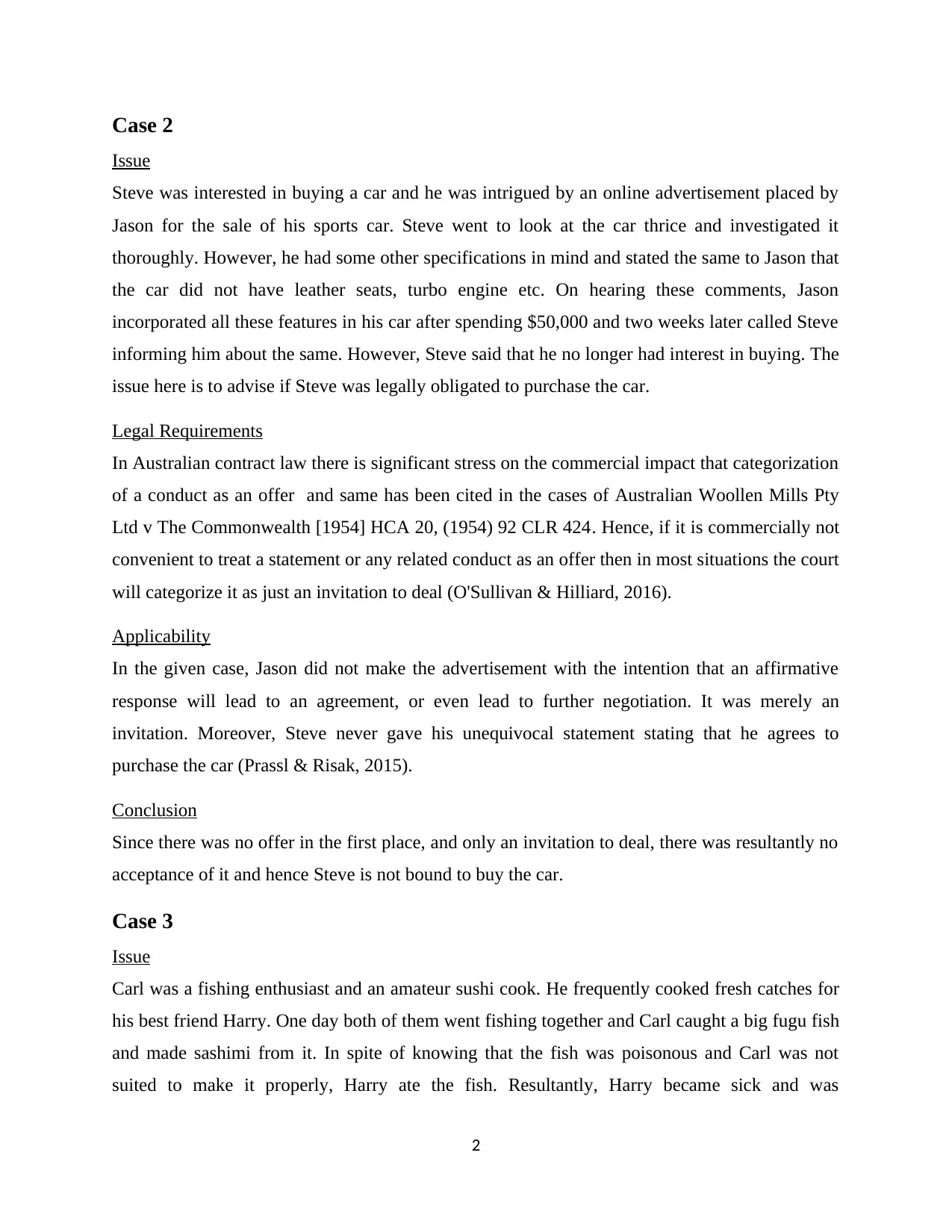
Case 2
Issue
Steve was interested in buying a car and he was intrigued by an online advertisement placed by
Jason for the sale of his sports car. Steve went to look at the car thrice and investigated it
thoroughly. However, he had some other specifications in mind and stated the same to Jason that
the car did not have leather seats, turbo engine etc. On hearing these comments, Jason
incorporated all these features in his car after spending $50,000 and two weeks later called Steve
informing him about the same. However, Steve said that he no longer had interest in buying. The
issue here is to advise if Steve was legally obligated to purchase the car.
Legal Requirements
In Australian contract law there is significant stress on the commercial impact that categorization
of a conduct as an offer and same has been cited in the cases of Australian Woollen Mills Pty
Ltd v The Commonwealth [1954] HCA 20, (1954) 92 CLR 424. Hence, if it is commercially not
convenient to treat a statement or any related conduct as an offer then in most situations the court
will categorize it as just an invitation to deal (O'Sullivan & Hilliard, 2016).
Applicability
In the given case, Jason did not make the advertisement with the intention that an affirmative
response will lead to an agreement, or even lead to further negotiation. It was merely an
invitation. Moreover, Steve never gave his unequivocal statement stating that he agrees to
purchase the car (Prassl & Risak, 2015).
Conclusion
Since there was no offer in the first place, and only an invitation to deal, there was resultantly no
acceptance of it and hence Steve is not bound to buy the car.
Case 3
Issue
Carl was a fishing enthusiast and an amateur sushi cook. He frequently cooked fresh catches for
his best friend Harry. One day both of them went fishing together and Carl caught a big fugu fish
and made sashimi from it. In spite of knowing that the fish was poisonous and Carl was not
suited to make it properly, Harry ate the fish. Resultantly, Harry became sick and was
2
Issue
Steve was interested in buying a car and he was intrigued by an online advertisement placed by
Jason for the sale of his sports car. Steve went to look at the car thrice and investigated it
thoroughly. However, he had some other specifications in mind and stated the same to Jason that
the car did not have leather seats, turbo engine etc. On hearing these comments, Jason
incorporated all these features in his car after spending $50,000 and two weeks later called Steve
informing him about the same. However, Steve said that he no longer had interest in buying. The
issue here is to advise if Steve was legally obligated to purchase the car.
Legal Requirements
In Australian contract law there is significant stress on the commercial impact that categorization
of a conduct as an offer and same has been cited in the cases of Australian Woollen Mills Pty
Ltd v The Commonwealth [1954] HCA 20, (1954) 92 CLR 424. Hence, if it is commercially not
convenient to treat a statement or any related conduct as an offer then in most situations the court
will categorize it as just an invitation to deal (O'Sullivan & Hilliard, 2016).
Applicability
In the given case, Jason did not make the advertisement with the intention that an affirmative
response will lead to an agreement, or even lead to further negotiation. It was merely an
invitation. Moreover, Steve never gave his unequivocal statement stating that he agrees to
purchase the car (Prassl & Risak, 2015).
Conclusion
Since there was no offer in the first place, and only an invitation to deal, there was resultantly no
acceptance of it and hence Steve is not bound to buy the car.
Case 3
Issue
Carl was a fishing enthusiast and an amateur sushi cook. He frequently cooked fresh catches for
his best friend Harry. One day both of them went fishing together and Carl caught a big fugu fish
and made sashimi from it. In spite of knowing that the fish was poisonous and Carl was not
suited to make it properly, Harry ate the fish. Resultantly, Harry became sick and was
2
Paraphrase This Document
Need a fresh take? Get an instant paraphrase of this document with our AI Paraphraser
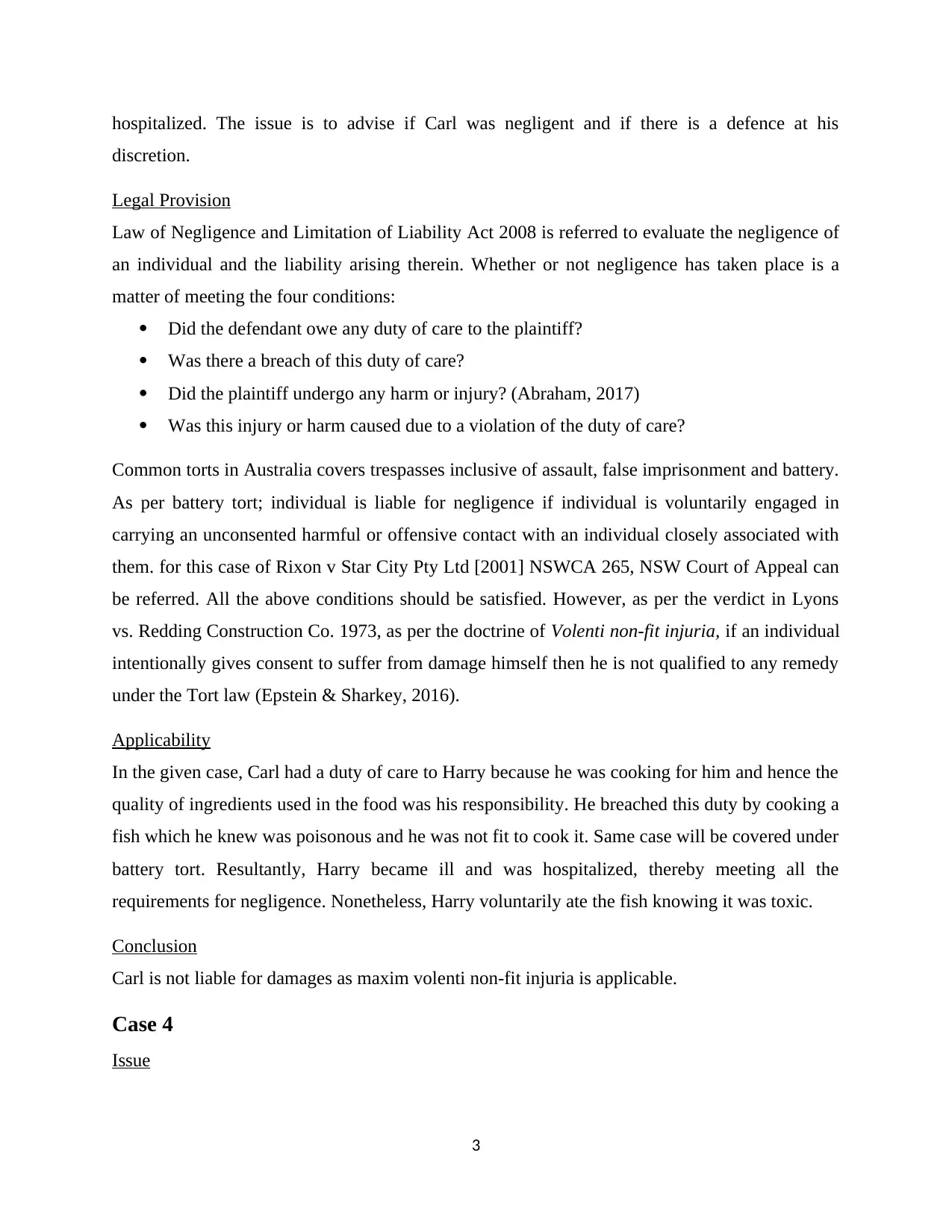
hospitalized. The issue is to advise if Carl was negligent and if there is a defence at his
discretion.
Legal Provision
Law of Negligence and Limitation of Liability Act 2008 is referred to evaluate the negligence of
an individual and the liability arising therein. Whether or not negligence has taken place is a
matter of meeting the four conditions:
Did the defendant owe any duty of care to the plaintiff?
Was there a breach of this duty of care?
Did the plaintiff undergo any harm or injury? (Abraham, 2017)
Was this injury or harm caused due to a violation of the duty of care?
Common torts in Australia covers trespasses inclusive of assault, false imprisonment and battery.
As per battery tort; individual is liable for negligence if individual is voluntarily engaged in
carrying an unconsented harmful or offensive contact with an individual closely associated with
them. for this case of Rixon v Star City Pty Ltd [2001] NSWCA 265, NSW Court of Appeal can
be referred. All the above conditions should be satisfied. However, as per the verdict in Lyons
vs. Redding Construction Co. 1973, as per the doctrine of Volenti non-fit injuria, if an individual
intentionally gives consent to suffer from damage himself then he is not qualified to any remedy
under the Tort law (Epstein & Sharkey, 2016).
Applicability
In the given case, Carl had a duty of care to Harry because he was cooking for him and hence the
quality of ingredients used in the food was his responsibility. He breached this duty by cooking a
fish which he knew was poisonous and he was not fit to cook it. Same case will be covered under
battery tort. Resultantly, Harry became ill and was hospitalized, thereby meeting all the
requirements for negligence. Nonetheless, Harry voluntarily ate the fish knowing it was toxic.
Conclusion
Carl is not liable for damages as maxim volenti non-fit injuria is applicable.
Case 4
Issue
3
discretion.
Legal Provision
Law of Negligence and Limitation of Liability Act 2008 is referred to evaluate the negligence of
an individual and the liability arising therein. Whether or not negligence has taken place is a
matter of meeting the four conditions:
Did the defendant owe any duty of care to the plaintiff?
Was there a breach of this duty of care?
Did the plaintiff undergo any harm or injury? (Abraham, 2017)
Was this injury or harm caused due to a violation of the duty of care?
Common torts in Australia covers trespasses inclusive of assault, false imprisonment and battery.
As per battery tort; individual is liable for negligence if individual is voluntarily engaged in
carrying an unconsented harmful or offensive contact with an individual closely associated with
them. for this case of Rixon v Star City Pty Ltd [2001] NSWCA 265, NSW Court of Appeal can
be referred. All the above conditions should be satisfied. However, as per the verdict in Lyons
vs. Redding Construction Co. 1973, as per the doctrine of Volenti non-fit injuria, if an individual
intentionally gives consent to suffer from damage himself then he is not qualified to any remedy
under the Tort law (Epstein & Sharkey, 2016).
Applicability
In the given case, Carl had a duty of care to Harry because he was cooking for him and hence the
quality of ingredients used in the food was his responsibility. He breached this duty by cooking a
fish which he knew was poisonous and he was not fit to cook it. Same case will be covered under
battery tort. Resultantly, Harry became ill and was hospitalized, thereby meeting all the
requirements for negligence. Nonetheless, Harry voluntarily ate the fish knowing it was toxic.
Conclusion
Carl is not liable for damages as maxim volenti non-fit injuria is applicable.
Case 4
Issue
3
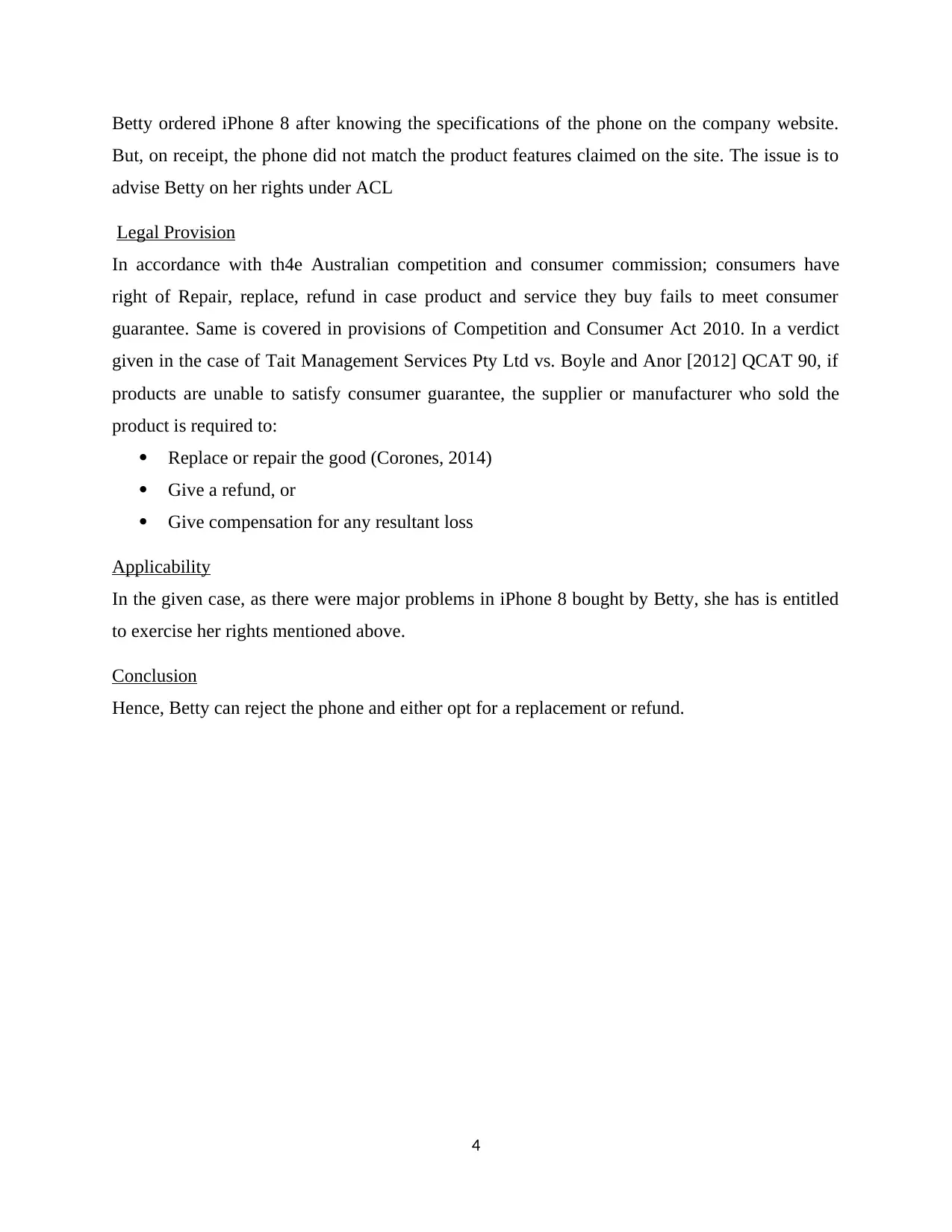
Betty ordered iPhone 8 after knowing the specifications of the phone on the company website.
But, on receipt, the phone did not match the product features claimed on the site. The issue is to
advise Betty on her rights under ACL
Legal Provision
In accordance with th4e Australian competition and consumer commission; consumers have
right of Repair, replace, refund in case product and service they buy fails to meet consumer
guarantee. Same is covered in provisions of Competition and Consumer Act 2010. In a verdict
given in the case of Tait Management Services Pty Ltd vs. Boyle and Anor [2012] QCAT 90, if
products are unable to satisfy consumer guarantee, the supplier or manufacturer who sold the
product is required to:
Replace or repair the good (Corones, 2014)
Give a refund, or
Give compensation for any resultant loss
Applicability
In the given case, as there were major problems in iPhone 8 bought by Betty, she has is entitled
to exercise her rights mentioned above.
Conclusion
Hence, Betty can reject the phone and either opt for a replacement or refund.
4
But, on receipt, the phone did not match the product features claimed on the site. The issue is to
advise Betty on her rights under ACL
Legal Provision
In accordance with th4e Australian competition and consumer commission; consumers have
right of Repair, replace, refund in case product and service they buy fails to meet consumer
guarantee. Same is covered in provisions of Competition and Consumer Act 2010. In a verdict
given in the case of Tait Management Services Pty Ltd vs. Boyle and Anor [2012] QCAT 90, if
products are unable to satisfy consumer guarantee, the supplier or manufacturer who sold the
product is required to:
Replace or repair the good (Corones, 2014)
Give a refund, or
Give compensation for any resultant loss
Applicability
In the given case, as there were major problems in iPhone 8 bought by Betty, she has is entitled
to exercise her rights mentioned above.
Conclusion
Hence, Betty can reject the phone and either opt for a replacement or refund.
4
⊘ This is a preview!⊘
Do you want full access?
Subscribe today to unlock all pages.

Trusted by 1+ million students worldwide
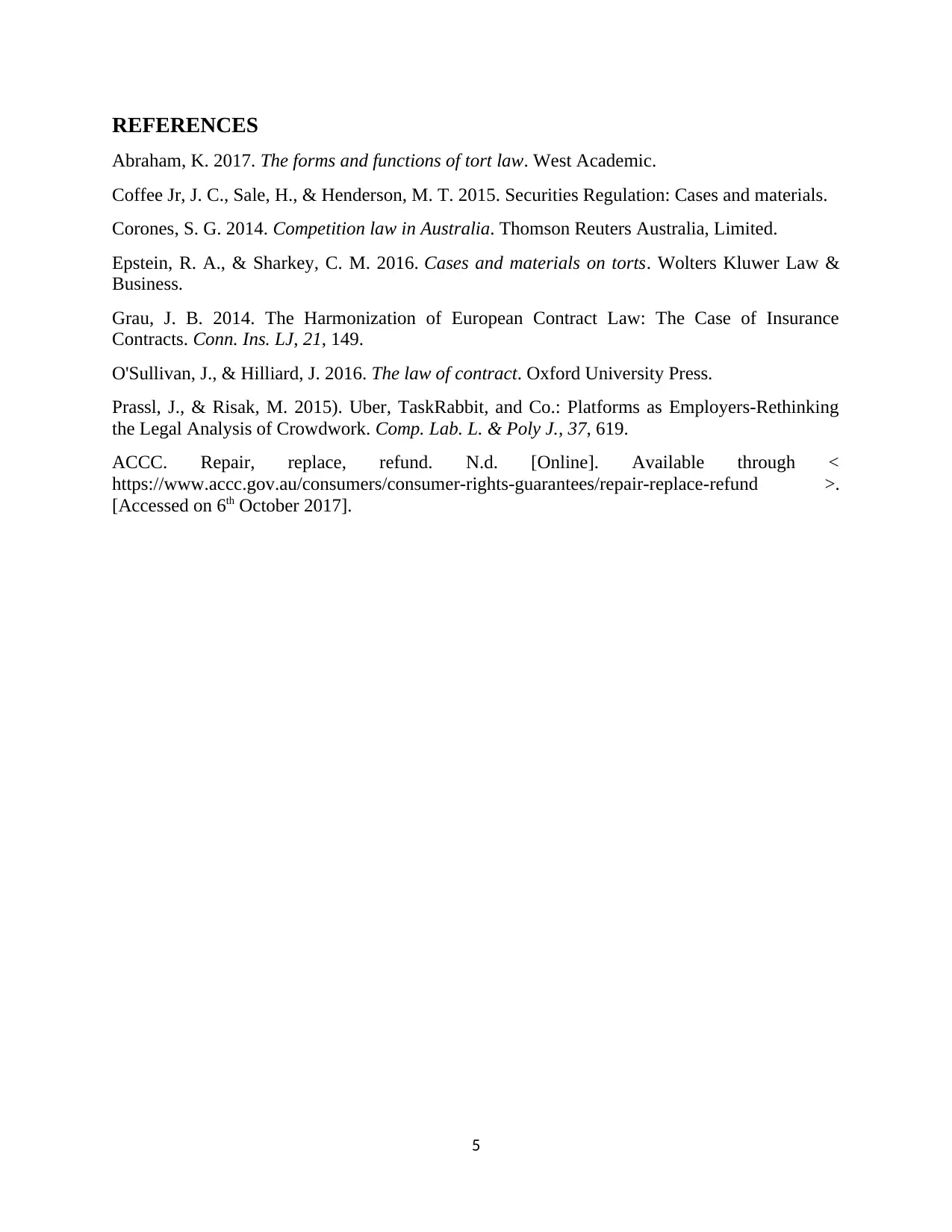
REFERENCES
Abraham, K. 2017. The forms and functions of tort law. West Academic.
Coffee Jr, J. C., Sale, H., & Henderson, M. T. 2015. Securities Regulation: Cases and materials.
Corones, S. G. 2014. Competition law in Australia. Thomson Reuters Australia, Limited.
Epstein, R. A., & Sharkey, C. M. 2016. Cases and materials on torts. Wolters Kluwer Law &
Business.
Grau, J. B. 2014. The Harmonization of European Contract Law: The Case of Insurance
Contracts. Conn. Ins. LJ, 21, 149.
O'Sullivan, J., & Hilliard, J. 2016. The law of contract. Oxford University Press.
Prassl, J., & Risak, M. 2015). Uber, TaskRabbit, and Co.: Platforms as Employers-Rethinking
the Legal Analysis of Crowdwork. Comp. Lab. L. & Poly J., 37, 619.
ACCC. Repair, replace, refund. N.d. [Online]. Available through <
https://www.accc.gov.au/consumers/consumer-rights-guarantees/repair-replace-refund >.
[Accessed on 6th October 2017].
5
Abraham, K. 2017. The forms and functions of tort law. West Academic.
Coffee Jr, J. C., Sale, H., & Henderson, M. T. 2015. Securities Regulation: Cases and materials.
Corones, S. G. 2014. Competition law in Australia. Thomson Reuters Australia, Limited.
Epstein, R. A., & Sharkey, C. M. 2016. Cases and materials on torts. Wolters Kluwer Law &
Business.
Grau, J. B. 2014. The Harmonization of European Contract Law: The Case of Insurance
Contracts. Conn. Ins. LJ, 21, 149.
O'Sullivan, J., & Hilliard, J. 2016. The law of contract. Oxford University Press.
Prassl, J., & Risak, M. 2015). Uber, TaskRabbit, and Co.: Platforms as Employers-Rethinking
the Legal Analysis of Crowdwork. Comp. Lab. L. & Poly J., 37, 619.
ACCC. Repair, replace, refund. N.d. [Online]. Available through <
https://www.accc.gov.au/consumers/consumer-rights-guarantees/repair-replace-refund >.
[Accessed on 6th October 2017].
5
1 out of 7
Related Documents
Your All-in-One AI-Powered Toolkit for Academic Success.
+13062052269
info@desklib.com
Available 24*7 on WhatsApp / Email
![[object Object]](/_next/static/media/star-bottom.7253800d.svg)
Unlock your academic potential
Copyright © 2020–2025 A2Z Services. All Rights Reserved. Developed and managed by ZUCOL.





